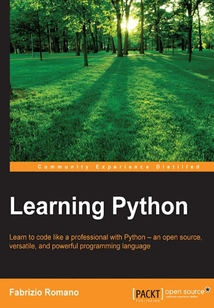舉報 

會員
Learning Python
最新章節:
Index
PythonisthemostpopularintroductoryteachinglanguageinU.S.topcomputerscienceuniversities,soifyouarenewtosoftwaredevelopment,ormaybeyouhavelittleexperience,andwouldliketostartoffontherightfoot,thenthislanguageandthisbookarewhatyouneed.Itsamazingdesignandportabilitywillhelpyoubecomeproductiveregardlessoftheenvironmentyouchoosetoworkwith.
目錄(112章)
倒序
- 封面
- 版權頁
- Credits
- About the Author
- Acknowledgements
- About the Reviewers
- www.PacktPub.com
- Support files eBooks discount offers and more
- Preface
- What this book covers
- What you need for this book
- Who this book is for
- Conventions
- Reader feedback
- Customer support
- Chapter 1. Introduction and First Steps – Take a Deep Breath
- A proper introduction
- Enter the Python
- About Python
- What are the drawbacks?
- Who is using Python today?
- Setting up the environment
- Installing Python
- How you can run a Python program
- How is Python code organized
- Python's execution model
- Guidelines on how to write good code
- The Python culture
- A note on the IDEs
- Summary
- Chapter 2. Built-in Data Types
- Everything is an object
- Mutable or immutable? That is the question
- Numbers
- Immutable sequences
- Mutable sequences
- Set types
- Mapping types – dictionaries
- The collections module
- Final considerations
- Summary
- Chapter 3. Iterating and Making Decisions
- Conditional programming
- Looping
- Putting this all together
- A quick peek at the itertools module
- Summary
- Chapter 4. Functions the Building Blocks of Code
- Why use functions?
- Scopes and name resolution
- Input parameters
- Return values
- A few useful tips
- Recursive functions
- Anonymous functions
- Function attributes
- Built-in functions
- One final example
- Documenting your code
- Importing objects
- Summary
- Chapter 5. Saving Time and Memory
- map zip and filter
- Comprehensions
- Generators
- Some performance considerations
- Don't overdo comprehensions and generators
- Name localization
- Generation behavior in built-ins
- One last example
- Summary
- Chapter 6. Advanced Concepts – OOP Decorators and Iterators
- Decorators
- Object-oriented programming
- Writing a custom iterator
- Summary
- Chapter 7. Testing Profiling and Dealing with Exceptions
- Testing your application
- Test-driven development
- Exceptions
- Profiling Python
- Summary
- Chapter 8. The Edges – GUIs and Scripts
- First approach – scripting
- Second approach – a GUI application
- Where do we go from here?
- Summary
- Chapter 9. Data Science
- IPython and Jupyter notebook
- Dealing with data
- Where do we go from here?
- Summary
- Chapter 10. Web Development Done Right
- What is the Web?
- How does the Web work?
- The Django web framework
- A regex website
- The future of web development
- Summary
- Chapter 11. Debugging and Troubleshooting
- Debugging techniques
- Troubleshooting guidelines
- Summary
- Chapter 12. Summing Up – A Complete Example
- The challenge
- Our implementation
- Implementing the Django interface
- Implementing the Falcon API
- Where do you go from here?
- Summary
- A word of farewell
- Index 更新時間:2021-07-30 09:42:12
推薦閱讀
- iOS面試一戰到底
- Mastering Natural Language Processing with Python
- Java入門很輕松(微課超值版)
- Web開發的貴族:ASP.NET 3.5+SQL Server 2008
- Data Analysis with IBM SPSS Statistics
- Backbone.js Blueprints
- Julia高性能科學計算(第2版)
- C++反匯編與逆向分析技術揭秘(第2版)
- Julia 1.0 Programming Complete Reference Guide
- Instant Debian:Build a Web Server
- Java EE 8 and Angular
- Elasticsearch Blueprints
- 深入淺出 HTTPS:從原理到實戰
- Learning Shiny
- 現代C++語言核心特性解析
- 基于JavaScript的WebGIS開發
- ReactJS Blueprints
- 看漫畫學Python:有趣、有料、好玩、好用(全彩版)
- Python程序設計基礎教程(慕課版)
- 軟件工程實用教程
- PHP 程序員面試筆試真題庫
- C語言從入門到精通(第6版)
- Statistics for Machine Learning
- 零基礎學Qt 6編程
- 從0到1:HTML5+CSS3修煉之道
- 深入淺出R語言數據分析
- 基于Kotlin的Spring Boot微服務實戰
- Go程序員面試算法寶典
- HBase入門與實踐(第2版)
- Raspberry Pi Android Projects

